More of AMD’s Brazos E-350 with the MSI X370 and Sony VAIO YB
by Jarred Walton & Dustin Sklavos on March 14, 2011 4:50 PM ESTApplication Performance: Better than Atom, Worse than CULV
We’ve already covered AMD’s E-350 twice: once on the desktop in Mini-ITX form, and a second time in the HP dm1z. Anand’s review uses some different benchmarks as well as an SSD, but if you’re interested in a preview of my SSD testing with the X370 that’s a good place to start. Using conventional HDDs and running the same test suite as we use with other laptops, all of the E-350 units are within spitting distance of each other, just as you’d expect. I’m switching up the list of laptops in our benchmark suite from the HP review, just to give a broader picture of the market. This time we’ve got single-core and dual-core CULV, single-core and dual-core Atom (both nettop and netbook models), an Arrandale ULV laptop, a couple ION equipped models, AMD’s Nile and Danube platforms, and even the 2010 MacBook Pro 13 running Windows 7 (note that this is the same as the current MacBook, only with a better LCD and chassis).
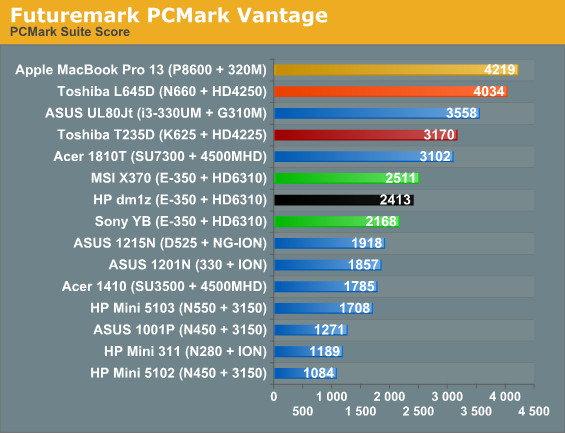


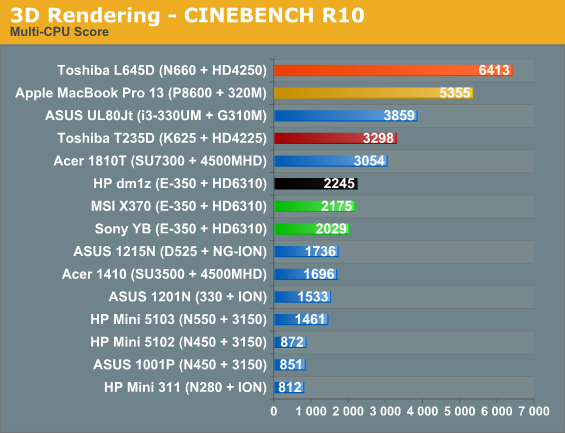


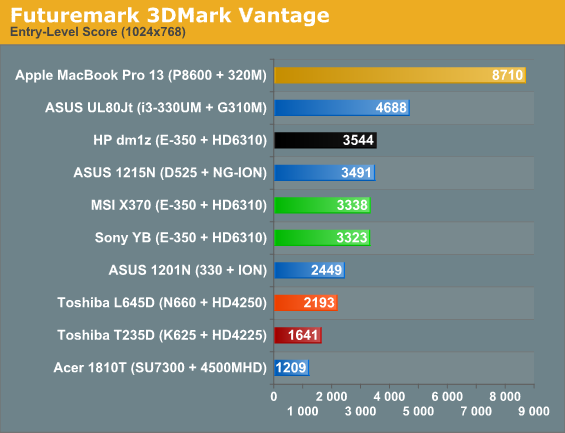

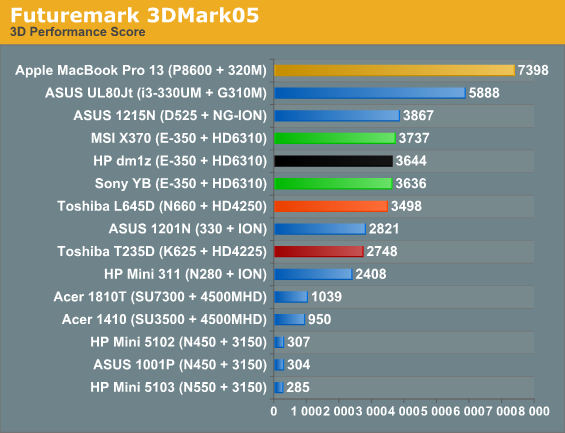
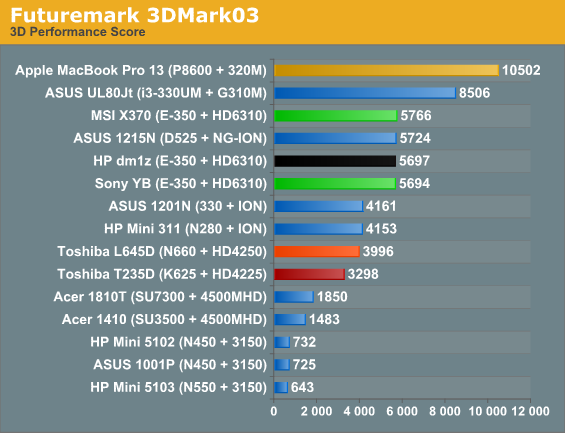
The E-350 systems post numbers that are relatively close, though not quite as close as we would have guessed. The PCMark results do more HDD related tests, so a difference there isn’t as surprising. We see the 7200RPM drives in the HP and MSI systems push ahead of the Sony; Vantage is more particular about your storage, representing an updated suite that’s more indicative of modern OS performance, so it looks like the 500GB Seagate 7200.4 beats the 320GB Western Digital Black. In PCMark05, though, WD turns the tables and the HP is back in the lead. Cinebench is nearly a pure CPU test, so seeing the MSI and HP leading the Sony by as much as 10% is a bit of a surprise. Oh, but wait... the Sony has a 32-bit version of Windows 7 on there, which can easily account for the PCMark Vantage and Cinebench results (two tests where we normally use 64-bit executables). x264 encoding is also heavily dependent on the CPU, particularly the second pass, but again we see variance with the MSI taking an 8-9% lead over the other two E-350 laptops. Still, even a 10% lead isn’t going to be particularly noticeable in day-to-day use.
When we start comparing E-350 with other platforms, things get interesting. Atom is clearly drawing the short stick, with the single-core variants placing at the bottom of our application performance charts. Dual-core Atom doesn’t fare much better, as even in heavily-threaded workloads like Cinebench SMP the E-350 is still faster, though x264 encoding is one area where the 330 and D525 manage to take a slight lead—it’s close enough to call it a draw, really. In single-threaded apps, though, all those extra cores go to waste and E-350’s Out of Order execution engine manages roughly double the performance of Atom. So, as far as Atom goes, even with ION the AMD E-350 is a superior platform—let’s not even bother with the 3DMark results.
Shift to CULV and things start to get a bit more difficult. CPU performance is in favor of the dual-core SU7300 across the board (PCMark05 factors in a decent amount of GPU performance, so toss out the 10% lead for Brazos there). PCMark Vantage puts the SU7300 almost 30% ahead of the E-350, though in turn Brazos leads the single-core SU3500 by a similar 35% margin. The other CPU tests give SU7300 a lead of anywhere from 28 to 38% over E-350, so the lead is pretty consistent. The single-core CULV actually leads in the single-threaded Cinebench result (not too surprising), but in multi-threaded tests the E-350 is anywhere from 30 to 70% faster. The problem with CULV is that you’re typically stuck with Intel’s GMA 4500MHD graphics; they’re enough for basic video decoding and Windows work, but in graphics the HD 6310 is three to four times as fast. We ran the Firefox 4 Beta/RC on both platforms, and it performed quite nicely on the E-350. While there’s no denying the fact that CULV is a faster CPU, as a platform we give the edge to E-350, especially when priced like the HP dm1z.
Comparing AMD’s Brazos to the recent Nile and Danube platforms, the story is similar to CULV: better CPU performance for the older platforms, but better graphics performance for Brazos. The K625 is anywhere from 30 to 50% faster than E-350, and the Phenom II N660 widens the gap to 60% to over 200% faster—yeah, that 3.0GHz core clock with a faster CPU architecture will get you there—but unlike CULV the battery life proposition isn’t all that compelling with Nile and Danube. Even with the CPU deficit, E-350 posts 3DMark results that are 30 to 115% higher than the K625 + HD4225; the lead over the faster N660 + HD4250 ranges from a scant 4% to as much as 62% depending on which 3DMark you look at.
Finally, let’s look at some of the newer and faster options with better graphics. The MacBook is twice as expensive as the HP dm1z, it’s also 50 to 150% faster in CPU/application performance. In the graphics tests, the 320M with P8600 is roughly twice the performance of the E-350. While we can certainly recommend the HP dm1 as an alternative, the higher priced Sony and MSI start to look very questionable. Arrandale ULV paired with a G 310M is likewise a better performing platform in every test. It provides 50 to 80% more CPU performance, and it also leads by 30 to 60% in 3DMark.
While perhaps the ASUS UL80Jt price is too high to be in direct competition, with Sandy Bridge now starting to show up we expect to see discounted Arrandale laptops for the next six months. One example of this is the recently launched ASUS U31Jg-A1; for $700 you get a Core i3-380M and NVIDIA GT 415M, plus NVIDIA’s Optimus Technology and the U-series’ 84Wh battery standard. If you can afford the extra $200 (40% higher price), and you’re not interested in an 11.6” chassis, such laptops are really going to put the squeeze on Brazos E-350. With a lower price than the MSI X350 (and presumably X370), we can’t come up with a single reason why anyone would skip the U31Jg and instead go for the MSI.










43 Comments
View All Comments
arthur449 - Tuesday, March 15, 2011 - link
One of the biggest issues I see with Anandtech.com isn't the lack of information in the bar graphs; it's the time it takes to look at the graphs and determine what you're looking at. The color coding for this review is extremely helpful in this regard.Green: Models being reviewed
Black: Models in direct competition
Blue: Other/Older models with similar performance in the database
In the future, it would be great to add the ability for users to choose from a list of pre-tested systems in their Anandtech.com account preferences. Those systems chosen would fill in the models typically listed in Blue, while the Black (chosen by author / editor) and Green would appear regardless. So, for example, users could choose a notebook, smartphone, GPU, CPU, SSD, and monitor that directly compares to what they consider a benchmark in that particular market.
Anyhow, that's just my 2 cents.
TLDR: I like what you did with the graphs.
7Enigma - Tuesday, March 15, 2011 - link
Agreed, it was a very easy read. Keep up the good work guys, this review (and more importantly the text discussions regarding the data) were excellent.yudhi717 - Tuesday, March 15, 2011 - link
the X370 already on sale in Indonesia at $489, there is also the U270 Light at $399, I don't know the configuration / spec.Samus - Tuesday, March 15, 2011 - link
I've had mine for two months and already noticed two design flaws. The right speaker grill is peeling off, and the screen bezel interfers with the keyboard and the keys are slowly chipping away at the bezels' plastic.A Thinkpad it is not, but flaws aside, I enjoy the laptop, but have reservations in recommending something with such build quality.
JGabriel - Tuesday, March 15, 2011 - link
I applaud the addition of a section on older, less intensive, games. While I doubt anyone is planning to play the latest DX11 shooters on this type of platform, it's good to know what kind of performance can be expected from slightly older eye candy like Oblivion, HL2, and Quake 4.
It might be a nice touch to add Prey and/or Portal to the list. Portal, in particular, seems like the kind of lighter weight game that might be popular on this type of platform.
duploxxx - Tuesday, March 15, 2011 - link
I found this a very strange review, for the first brazos review you compare the HP all the time against the atom, which is the target to start with.Now you drag along any culv - SNB - macbook or wathever against it most of them in a way higher price range and start complaining about performance against others?
Its OEM who define how they will build the systems, with a small margin of AMD defining the upper limit, not like Intel who hard limits all bits and pieces on there platform.
So now you have it, OEM create some designs which to my opinion are not meant to be for brazos, those are netbook cpu's.
Anything higher can soon be equiped with E2 and A4 LInao which will knock down any CULV performance wise but AMD should do some platform research and speedbinning for lower TDP bins to compete on all aspects.
JarredWalton - Tuesday, March 15, 2011 - link
How many Atom systems do you need to see? I put in three netbook Atoms, plus the Mini 311 (Atom) where I had results, plus the nettop D525 in the 1215N. Then I added to that CULV, ULV, SNB, MBP13, and a several others for good measure. It's called perspective, and never once did I say that Brazos should be faster than Sandy Bridge. The problem for some of these systems is that we're going to start seeing dual-core Sandy Bridge priced around $700 for a decent setup (4GB RAM, 500GB HDD) and that's useful to put into the charts.My thinking here is that I wanted to include every reasonable contender in the IGP space. So that's why the MBP13 comes along (both versions), and why CULV is in there, and why Arrandale and SNB are in there. CULV and the MBP13 also compete pretty directly against Brazos in battery life, which is another good reason to bring them along. It's one thing to get two or three times the performance but 1/3 the battery life for twice the cost; it's quite another to get double the performance, similar battery life, and pay only 50% more, don't you think? But of course, I should only show Brazos against systems where it can come out ahead, because that's what it's "meant to compete against."
What's funny is that you state that the "first Brazos review compared HP to Atom". Um... did you look at the graphs? http://www.anandtech.com/show/4187/ I have over twice the number of Atom systems in this time; I just added some other points of reference. The result? In my 15-item application charts Brazos sits around the middle, compared to third from last in Dustin's HP review. In games, we already know Brazos is going to get clobbered, but it's still important to show how modern titles run on the platform. However, I added a whole page of 23 additional, older/less demanding titles (several days of work there!) just to give a clearer picture.
sebanab - Tuesday, March 15, 2011 - link
I'm very happy to hear you will also be covering the Ontario.I own one (Ao522) and there is one issue I would like to bring to your attention:
With Brazos, AMD has also introduced what they call "Dynamic contrast and brightness adjust". Problem is that the features are on all the time and can't be turned off. And they can get really annoying while surfing the web.
I think it's a bug while there are some options regarding this in CCC but they don't have any effect.
I'm also very curious for the X120e , while I have heard that the LCD is actually acceptable.
(also please check the fan speed settings)
L. - Tuesday, March 15, 2011 - link
I've personally come to hate HP for their lack of decent products, and their very efficient modern capitalist view (read : designing computers to break right after the 1-year warranty), and my guess is that should heavily influence someone's choice in a new computer/toy.On my side, every HP laptop I have seen has had issues (except one that is 12 years old), several from an outsourcing deal at a client's had their mini-fans die twice in a year, my father's hp laptop had to go in RMA even before the first year, my little sister's HP just the same, my godfather's laptop ... again.
So seriously, I don't know what everyone's perception of HP is, but from my side those people are unable to provide reliable laptops (and I would never not build a desktop).
In that sense, if anyone comes to me asking for a reference for laptops, I always start with : "Take a decent brand, like Dell, or Asus, or ..."
Also, my personal experience again, but I had two MSI motherboards and both of them lived only one year, another reason for me not to go there either.
As a summary : my point of view is surely of little interest, but a track record of actual reliability of manufacturers could be an interesting input to your reviews (as in how HP fails at delivering stuff that holds for 5 years, or how that HDD company's failure rates are unacceptable etc.) as that has some influence on customer's perception of service (like if my HP laptop is in RMA every 6 months for 2 weeks, I need a second laptop).
Also, thanks for the reviews.
olbrannon - Tuesday, March 15, 2011 - link
It too runs the 350 brazos w/ Windows 7 @64 bitI love the size if the screen and the keyboard is -huge- paid $399 + tax. One of the game's I am not seeing here that I play is Dragon Age. It seems quite playable with only some occasional lags on loading areas and some minor frame dropping on occasion. No hdmi out thought only vga. I also have Neverwinter Nights 1 & 2 haven't tried to play them yet.
I did get a chilpad for it though. thing can get kind of warm running these games.
It's my first purchase ever of an off the shelf system of any kind quite happy with it so far.
Speakers aren't bad for such a small laptop either